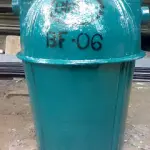
You may have a house with an old cold water tank in the loft and want to remove it. But a water tank in a loft removal and how easy it is depends on what the old water tank is made from makes the removal a challenge.
How you remove the old cold water tank from the loft is to cut it up so the pieces fit through the loft hatch. But before you cut the old water tank into pieces make sure it’s not made from asbestos and the old water connections are disconnected.
Why is there a water tank in my loft?
Cold water storage tanks are normally found in lofts and are filled by mains pressure water on a ball valve system. The water stored in the loft-tanks is used to supply the hot and cold water taps on your bath and to fill your toilet cisterns.
What are the two water tanks in the loft?
There are often two cold water tanks in a loft, and these include:
- Low pressure cold water storage tank. This will be the larger of the two tanks.
- Heating system and boiler-fed water tank. This will be the smaller of the two tanks.
1. Removal of a low pressure cold water storage tank from a loft
Low pressure cold water storage tanks are used for gravity-fed systems. Gravity-fed low pressure water systems are among the most common types of domestic water systems found in homes. The cold water storage tank is normally installed in your loft and feeds low pressure cold water to your hot water tank and to all low-pressure taps and toilet cisterns across your home.
When can a low pressure cold water tank be removed from your loft
A low pressure cold water storage tank can be removed when a house has a combi-boiler installed, which is also known as a tankless water heater. But this can only be done once all the water to the taps are directly fed from the high pressure mains supply.
2. Heating system and boiler-fed water tank and when it can be removed from your loft
The other type of cold water storage tank in lofts includes a feed and expansion tank. This feed and expansion tank is connected to your heating system if it’s not a pressurised heating system.
A boiler-fed water tank can be removed if your heating system is changed to a pressurised system. Once your heating system is pressurised it no longer needs a feed from this expansion tank. But instead the system is fed directly from the mains.
Measure the loft hatch to work out how small to cut the pieces of the water tank
Before you thinking about cutting up your old cold water tank measure the size of your loft hatch first. It’s better to measure this first to avoid an unnecessary number of cuts.
For example, you may begin by cutting the old water tank in half. But you find that each half won’t fit through the loft hatch. You are then faced with cutting each half into two more pieces. Which means a total of three-cuts. However, if you measure your loft hatch to find that if you cut the tank into thirds, you only need to make two cuts.
However, if the old water tank is galvanised steel, three cuts into quarters might be better to create lighter pieces to get them down the loft hatch.
It can be hot and dusty working in a loft, so the least amount of time you spend cutting the better.
Removing old plastic water tank from loft
It’s relatively easy to remove an old plastic water tank from your loft as this is easy to cut up to fit through your loft hatch. Once the plastic water tank has been disconnected from the mains, it can be cut up using a jigsaw. Alternatively you can use a reciprocating saw to cut the old water tank into sections.
You could also use a hacksaw or a hand saw,. But this will take much longer to make the cuts than if you use an electric saw. But if you use a hacksaw don’t use the adjustable frame type as this limits the depth of there cut.
Removing old galvanised metal water tank from loft
To remove an old galvanised water tank is best achieved by cutting it up using a reciprocating saw. This will not be an easy job as galvanised steel is strong and heavy. So you will need to cut the tank into small enough pieces to fit through the loft hatch. Plus the pieces need to be small enough for you to be able to lift.
When you hire or buy a reciprocating saw make sure to get metal cutting blades. You may need more than one to do the job. But this depends on how large the old water tank is and how many cuts are necessary. I suggest you buy a least three metal blades.
You may be able to cut your old galvanised water tank with a jigsaw, but make sure you choose the right metal blade. Also, this may take a lot more time to cut than using a reciprocating saw. You may also consider a hacksaw, but this will take even longer. Also, if you do use a hacksaw, you need to use a blade-holder hacksaw. Take a read of this article about cutting metal.
Don’t be tempted to use an angle grinder to cut up your galvanised water tank whilst it’s still in your loft. When you use an angle grinder to cut through metal they produce significant sparks. You may set fire to your loft with these sparks, which would be a disaster.
Also, don’t use a disc cutter either, as this will also produce dangerous sparks that may cause a house fire.
Removing old asbestos water tank from loft
If you suspect your old cold water tank to be made from asbestos cement do not cut this up. Asbestos can cause serious diseases and once diagnosed it’s often too late to do anything about it. If your old water tank is made from asbestos, you may be better to leave it in your loft. But if you want to get it removed find a specialist asbestos water tank removal service.
Warning: If you are not sure what your old water tank is made from, or certainly if you suspect it might be made from asbestos cement, be cautious.
Other considerations when removing an old cold water tank from a loft yourself
- Use cutting oil on there blade of your reciprocal saw to help lubricate the cutting action. Oil will help to keep the blade cool whilst cutting. It’s not cheap, but sticky chainsaw oil would work.
- You may also consider using an alligator saw, but these are not cheap tools. In which case you could hire one from a tool hire shop.
- After cutting up and removing your old water tank make sure to blank off the old pipework. The last thing you want is for one of these pipes to start leaking in your loft over time.
- Before you start cutting up your old water tank, make sure to remove any residual water from the bottom of the tank first. If the old water tank has been in the loft for a while unused it’s likely that any water will have evaporated.
- You may need to add some extra loft insulation under where the old water tank sat. This is cheap and can easily be purchased from a DIY store.
How to get water tank out of loft
To get get your old water tank out of your loft it will need to be cut up first. If it’s a plastic water tank this will be easy as the pieces will be light. But if your old water tank is made from galvanised steel this won’t be so easy as it will be very heavy.
The best way to get a galvanised water tank out of your loft is to ask for help to remove the pieces. But if you can’t get any help, you’ll need to cut the old tank up into smaller pieces you can manage.
Extra safety when removing an old water tank from your loft
- When you are removing your old water tank from your loft make sure to wear goggles when you cutting it up. Metal in your eyes is painful and could blind you.
- You should also wear a face mask too, as lofts are very dusty and you’ll get fine dust in your lungs if you don’t wear a mask.
- You may also be advised to wear ear defenders too. Using electrical tools in a confined space will be noisy.
- Be careful not to fall through the gaps between the joists if your loft is not boarded out. I suggest you take some boarding up into the loft to put next to the old water tank before you begin to cut it up. use this board to kneel or stand on to make sure you don’t accidentally put your feet in the wrong places when you’re focused on cutting. It’s easily done to be focused on one thing and accidentally put your foot where it shouldn’t be. Otherwise you may end up with a large hole in your ceiling.
- Be very careful when carrying heavy galvanised steel tanks down loft ladders. You don’t want this to fall on you or anyone who is helping you as these are very heavy.
How much does it cost to remove a water tank?
To remove an old water tank from a loft will cost between £100 to £300 depending on what the tank is made from. An older plastic water tank will be cheaper to remove than an old galvanised steel tank. But if you have an old asbestos water tank this will be more expensive as it will require a specialist removal service.
To tidy up the old pipework will generally be an extra charge to the removal service. But if your water tank is still connected to the mains, this will cost more to disconnect it first. However, if your water tank is still connected to the mains water, you probably should not be removing it in the first place.
That’s not to say that when the gravity-fed water was was decommissioned that the mains water feed to the tank was also disconnected. Make sure the water feed to the tank is no longer working to avoid any floods in your loft.
Final thoughts on water tank in loft removal
If you don’t need the loft space you don’t have to remove your old cold water storage tank. It won’t do any harm to leave this tank in your loft. But if of course you want to use all the space and you intend to board-out your loft space, you may want to have it removed.
If you are having a loft conversion you will want all the space you can get. But will be able to get the builders you use for the loft conversion to remove the old water tank as part of the job.
Only remove a water tank if it’s no longer connected to the mains and is not in use. Also, make sure to dispose of the old tank responsibly too. Most tips will take both plastic and galvanised steel tanks.
I hope you’ve enjoyed this article about water tank in loft removal
If you’ve enjoyed this article about “water tank in loft removal”. If you have please share it on your favourite social media site.
Also, if you have any questions, please feel free to comment below too. Please also share any of your experiences with properties you’ve bought. Alternatively, if you need more help, please feel free to contact us on our contact us page here. Or join the discussion and ask your question in the property forum.




